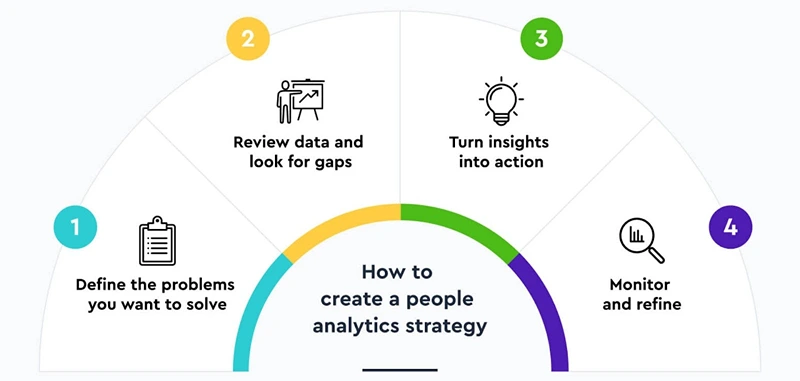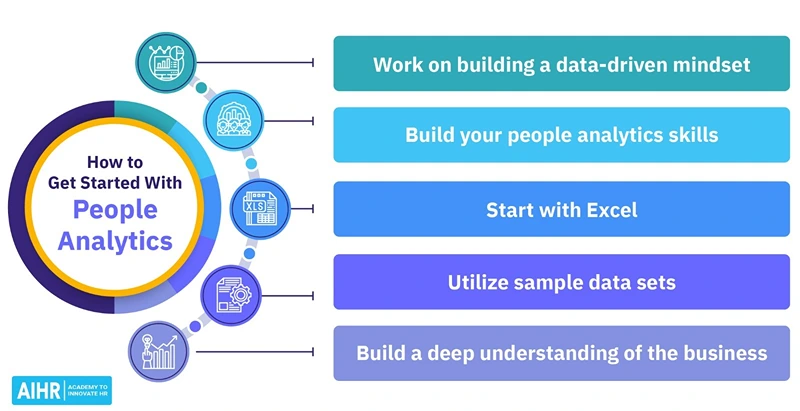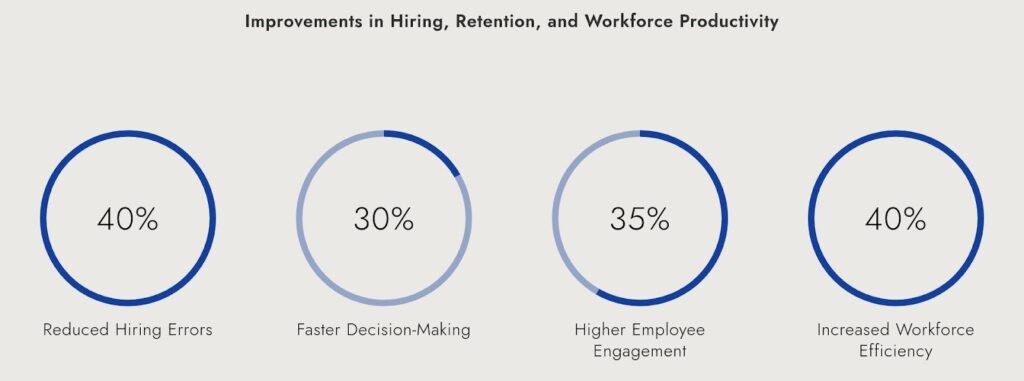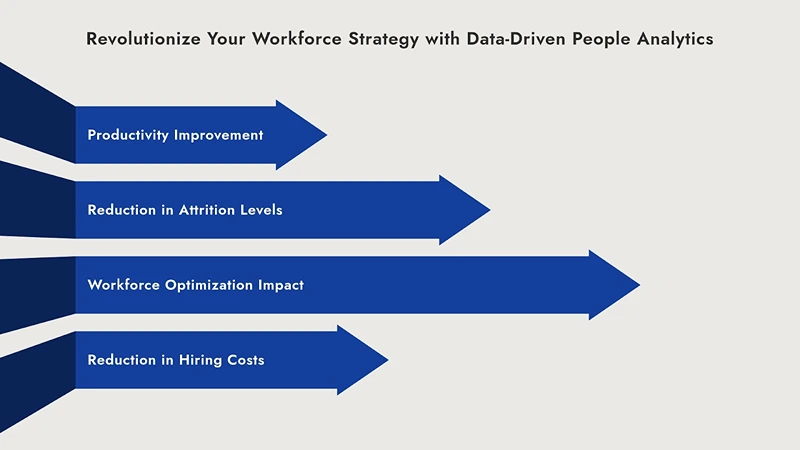People analytics, in particular, has quickly become a core function for HR leaders trying to fine-tune employee planning, talent selection, and business value outcomes in a transforming business environment. Currently, data-driven decision-making frameworks are predominant, and organizations are tapping into the power of people analytics software to examine employee trends, retention strategies, and outplacement predictive models.
McKinsey and Company, for instance, reports that people analytics improves productivity by up to 25% and reduces attrition levels by 30%. In another study, 72% of HR executives surveyed stated that a people analytics framework has a significant impact on workforce optimization with regard to overall workforce success.
This article unveils the revolutionary impact of people analytics on HR functions, the basic parts of a people analytics plan, and the advances of predictive analytics in outplacement, hiring, and retention.

The Power of People Analytics in Driving HR Efficiency and Talent Management
Traditionally, HR decisions were based on experience and intuition. However, in today’s data-driven workplace, HR teams must rely on people analytics software to make evidence-based decisions that improve hiring, retention, and employee engagement.

How People Analytics Are Transforming HR Functions
- Data-Driven Talent Acquisition – Predictive analytics allow organizations to scrutinize candidate data in advance and forecast hiring needs to ascertain the best candidate fit for organizational talent.
- Improved Workforce Planning – People analytics software is utilized by HR leaders to monitor the movement of internal personnel, succession planning, and overall workforce engagement.
- Employee Retention Optimization – AI insights can predict impending attrition and enable proactive retention measures by HR teams.
- Enhanced Performance Management – HR teams take a more proactive approach to bespoke learning and career growth opportunities by tracking employee performance trend data.
- Diversity, Equity, and Inclusion (DEI) Strategies – People analytics provide tools for firms to practically measure the effectiveness of their DEI initiatives and ensure equal opportunity is not undermined in the hiring process.
With the introduction of HR analytics tools, businesses reported a 35% improvement in the accuracy of planning and a 20% increase in employee satisfaction, as reported by Freeman in The Harvard Business Review.
Essential Components of a People Analytics Strategy for Workforce Optimization
A successful people analytics strategy integrates data from multiple sources, offering a comprehensive view of workforce trends. HR teams must build a scalable, data-driven framework to optimize HR decision-making.
Key Elements of a Strong People Analytics Strategy
- Data Collection and Integration
- HR teams must consolidate data from HRIS, ATS, payroll systems, and performance tracking tools.
- Ensure data standardization across different platforms for accurate reporting.
- AI-Driven Predictive Analytics
- Machine learning algorithms help HR professionals forecast workforce trends and hiring needs.
- People analytics tools predict future workforce challenges, ensuring proactive problem-solving.
- Real-Time Workforce Dashboards
- HR teams need customizable dashboards to analyze employee retention, engagement, and productivity metrics.
- AI-powered insights provide actionable recommendations for talent acquisition and performance improvement.
- Employee Sentiment and Engagement Analysis
- Sentiment analysis tools track employee satisfaction, workplace well-being, and team morale.
- Predictive models detect early signs of burnout or disengagement, allowing HR to improve employee experience.
A Deloitte workforce analytics report found that companies using predictive HR analytics reduce hiring errors by 40% and experience a 30% faster decision-making process.
The Role of Predictive Analytics in Hiring, Retention, and Workforce Productivity
Predictive analytics has transformed HR decision-making, allowing businesses to make smarter hiring decisions, optimize employee retention, and enhance workforce productivity.

How Predictive Analytics Enhances Workforce Strategy
- AI-Driven Talent Acquisition
- Machine learning algorithms analyze historical hiring data, candidate experience, and job fit.
- Predictive analytics tools help HR teams forecast hiring success rates and identify top-performing candidates.
- Attrition Forecasting and Retention Strategies
- AI models assess turnover risk factors by analyzing employee engagement trends and workplace sentiment.
- Companies using predictive analytics software reduce employee churn by 25% through targeted retention initiatives.
- Optimizing Employee Productivity
- AI-driven insights identify performance improvement areas and recommend training programs.
- Predictive analytics helps HR teams implement skills-matching initiatives, improving workforce utilization.
A PwC workforce study found that businesses leveraging predictive HR analytics tools experience 35% higher employee engagement and a 40% increase in overall workforce efficiency.
How JobsPikr’s People Analytics Solutions Enhance Workforce Management
Why Choose JobsPikr for AI-Powered HR Analytics? JobsPikr provides a real-time HR analytics platform, offering data-driven insights, predictive workforce modeling, and AI-powered hiring intelligence to improve HR efficiency and decision-making.
Key Features of JobsPikr’s People Analytics Solutions
- AI-Driven Workforce Forecasting
- Predicts hiring needs, workforce demand, and emerging job trends.
- Uses machine learning models to enhance succession planning and internal talent mobility.
- Real-Time Hiring and Talent Market Insights
- Tracks global workforce trends to help HR leaders optimize recruitment strategies.
- Predictive data analytics ensures proactive talent acquisition planning.
- Advanced Employee Engagement Analytics
- AI-powered engagement metrics analyze employee sentiment, job satisfaction, and workplace culture.
- Enables HR teams to design targeted engagement programs that improve workforce morale.
- Customizable HR Analytics Dashboards
- Provides interactive, real-time workforce intelligence dashboards.
- HR teams can generate custom reports on hiring, performance, and workforce diversity metrics.
A Statista HR Tech report found that companies using AI-driven people analytics software improve workforce retention by 40% and reduce hiring costs by 35%.

Conclusion
As businesses continue to embrace HR digital transformation, implementing a data-driven people analytics strategy is key to workforce optimization, talent retention, and employee engagement. By leveraging AI-powered HR analytics tools, organizations can make informed decisions that enhance workforce efficiency and long-term business growth.
For enterprises looking to integrate predictive people analytics into their HR strategies, JobsPikr’s AI-driven workforce analytics software provides real-time workforce insights, predictive hiring models, and AI-powered decision-making tools.Sign up with JobsPikr today to access AI-powered people analytics solutions and transform your workforce management strategy!



